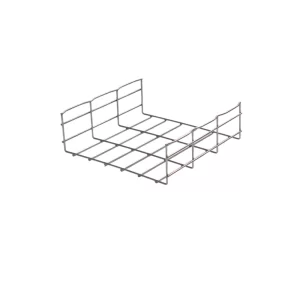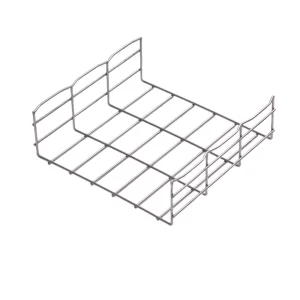In the world of electrical installations and cable management, wire mesh cable trays play a crucial role. These trays are designed to provide a structured and organized way to route and support electrical cables. With their unique characteristics and advantages, wire mesh cable trays are widely used in various industries and applications. In this article, we will explore what a wire mesh cable tray is and its many uses.
Cable management is essential in any electrical installation to ensure the safe and efficient operation of electrical systems. Wire mesh cable trays offer a practical solution for organizing and protecting cables, while also providing easy access for maintenance and troubleshooting. These trays are made of wire mesh, which allows for ventilation and visibility of the cables, making them an ideal choice for many applications.
What is a Wire Mesh Cable Tray?
A wire mesh cable tray is a type of cable management system that consists of a series of wires welded or woven together to form a tray-like structure. The wire mesh is typically made of steel, stainless steel, or aluminum, depending on the application requirements. The trays come in various sizes and configurations to accommodate different cable sizes and quantities.
Wire mesh cable trays are designed to support and route electrical cables, data cables, and other types of wiring. They can be installed horizontally, vertically, or at an angle, depending on the layout of the installation. The trays are usually mounted on walls, ceilings, or under raised floors to provide a neat and organized cable routing solution.

Features and Advantages of Wire Mesh Cable Trays
1. Ventilation
One of the main advantages of wire mesh cable trays is their excellent ventilation. The open wire mesh design allows air to circulate freely around the cables, preventing heat buildup. This is particularly important in applications where cables generate a significant amount of heat, such as in data centers or industrial settings.
The ventilation provided by wire mesh cable trays helps to extend the lifespan of the cables and reduces the risk of overheating and fire hazards.
2. Visibility
Another benefit of wire mesh cable trays is their visibility. The open design allows for easy inspection of the cables, making it easier to identify and troubleshoot any issues. This can save time and effort during maintenance and repair activities.
Visibility also makes it easier to add or remove cables without having to disassemble the entire tray. This flexibility is especially useful in dynamic environments where cable configurations may change frequently.
3. Strength and Durability
Wire mesh cable trays are made of strong materials such as steel or stainless steel, which makes them highly durable and able to withstand heavy loads. They can support large quantities of cables without sagging or deforming.
The welded or woven construction of wire mesh cable trays provides additional strength and stability, ensuring that the cables are securely held in place.
4. Flexibility and Customization
Wire mesh cable trays are highly flexible and can be easily customized to fit specific installation requirements. They can be cut, bent, and shaped to fit around corners, obstacles, and other architectural features.
Different accessories such as brackets, hangers, and covers can be added to wire mesh cable trays to further enhance their functionality and adaptability.
5. Cost-Effective
Wire mesh cable trays are often a cost-effective solution compared to other types of cable management systems. They are relatively inexpensive to manufacture and install, and their durability and longevity make them a good investment in the long run.
Additionally, the ventilation and visibility features of wire mesh cable trays can reduce the need for additional cooling and inspection equipment, further saving costs.
Applications of Wire Mesh Cable Trays
1. Industrial Settings
Wire mesh cable trays are widely used in industrial environments such as factories, warehouses, and manufacturing plants. They are ideal for routing cables for machinery, control panels, and other electrical equipment.
The strength and durability of wire mesh cable trays make them suitable for withstanding the harsh conditions often found in industrial settings, such as vibration, dust, and moisture.
2. Data Centers
In data centers, wire mesh cable trays are used to manage the large number of cables required for servers, switches, and other networking equipment. The ventilation and visibility features are crucial for maintaining the proper temperature and ensuring easy access for maintenance.
Wire mesh cable trays can be configured in different heights and widths to accommodate the high-density cable layouts found in data centers.
3. Commercial Buildings
Wire mesh cable trays are also commonly used in commercial buildings such as offices, hospitals, and shopping malls. They provide a neat and organized way to route cables for lighting, power outlets, and communication systems.
The flexibility and customization options of wire mesh cable trays make them suitable for installations with complex architectural designs and limited space.
4. Outdoor Installations
Wire mesh cable trays can be used in outdoor applications such as power distribution lines, telecommunications networks, and street lighting. They are designed to withstand exposure to the elements and provide reliable cable support.
Stainless steel wire mesh cable trays are often preferred for outdoor installations due to their corrosion resistance.

Installation and Maintenance of Wire Mesh Cable Trays
1. Installation
Wire mesh cable trays are relatively easy to install. They can be mounted on walls, ceilings, or under raised floors using brackets, hangers, or clips. The trays can be joined together using connectors or couplers to create longer runs.
During installation, it is important to ensure that the trays are level and properly supported to prevent sagging or deformation. The cables should be neatly arranged and secured within the trays to prevent damage and ensure proper ventilation.
2. Maintenance
Regular maintenance of wire mesh cable trays is essential to ensure their proper functioning and longevity. This includes inspecting the trays for signs of damage, such as bent wires or loose connections.
Cables should be checked for wear and tear, and any damaged cables should be replaced promptly. The trays should be cleaned periodically to remove dust and debris, which can affect ventilation and visibility.
Wire mesh cable trays are a versatile and practical solution for cable management in various industries and applications. Their ventilation, visibility, strength, flexibility, and cost-effectiveness make them an ideal choice for many installations. Whether in industrial settings, data centers, commercial buildings, or outdoor applications, wire mesh cable trays provide a reliable and organized way to route and support electrical cables. By understanding the features and uses of wire mesh cable trays, you can make an informed decision when choosing a cable management system for your specific needs.

